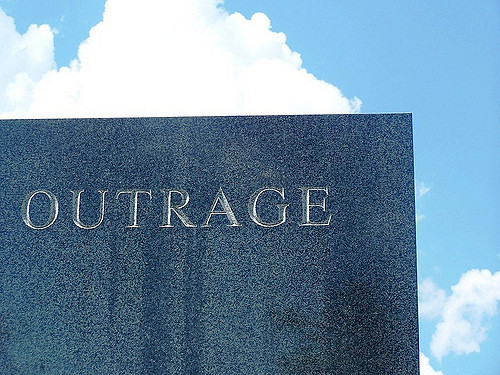Before last weekend gave a whole new meaning to “Charlottesville” and before GoDaddy and Google and several other web hosting companies refused to host a Neo-Nazi website, BuzzFeed News published a study in early August about partisan websites and Facebook pages (first link below) revealing the money motive behind many of the sites. Aside from financial gain, we already knew that stirring up anger on the internet is an effective way to influence public opinion. But why does online outrage – real or not – work so well? Is there some fatal flaw in the internet that lends itself to such partisanship? As one of the early creators of the internet said (quoted in the Pew Research Center article linked below), “We didn’t focus on how you could wreck this system intentionally.”
- Inside the partisan fight for your news feed (BuzzFeed | Craig Silverman, Jane Lytvynenko, Lam Thuy Vo and Jeremy Singer-Vine) “The interviews and data reveal a large, often interconnected world where Facebook plays kingmaker as much as it crushes dreams, where anger and stoking partisan hatred are core strategies on the right and left, and where the biggest players are working to secure dominance by partnering with, or acquiring, competitors and launching new sites to flood the market so new players can’t gain a foothold.”
- The fate of online trust in the next decade (Pew Research Center | Lee Rainie and Janna Anderson) “Trust has not been having a good run in recent years, and there is considerable concern that people’s uses of the internet are a major contributor to the problem. […] Moreover, the rise of the internet and social media has enabled entirely new kinds of relationships and communities in which trust must be negotiated with others whom users do not see, with faraway enterprises, under circumstances that are not wholly familiar, in a world exploding with information of uncertain provenance used by actors employing ever-proliferating strategies to capture users’ attention.”
- Fake news and partisan epistemology (Kennedy Institute of Ethics | Regina Rini) “[…] people believe fake news because they acquire it through social media sharing, which is a peculiar sort of testimony. Social media sharing has features that reduce audience willingness to think critically or check facts. This effect is amplified when the testifier and audience share a partisan orientation. Shared partisan affiliation encourages testimony recipients to grant more credibility to testifiers than would otherwise be warranted.”
- Study: Breitbart-led right-wing media ecosystem altered broader media agenda (Columbia Journalism Review | Yochai Benkler, Robert Faris, Hal Roberts, and Ethan Zuckerman) “Rather than ‘fake news’ in the sense of wholly fabricated falsities, many of the most-shared stories can more accurately be understood as disinformation: the purposeful construction of true or partly true bits of information into a message that is, at its core, misleading. Over the course of the election, this turned the right-wing media system into an internally coherent, relatively insulated knowledge community, reinforcing the shared worldview of readers and shielding them from journalism that challenged it.”
Articles from Ohio Web Library:
- Polarization as a function of citizen predispositions and exposure to news on the internet. (Journal of Broadcasting & Electronic Media, Sept. 2015, p.381-398 | David Tewksbury and Julius Matthew Riles)
- Party polarization, media choice, and mass partisan-ideological sorting. (Public Opinion Quarterly, 2016 Supplement, p. 272-297 | Nicholas T. Davis and Johanna L. Dunaway)
- Fake news expert on how false stories spread and why people believe them. (Fresh Air (NPR), 12/14/2016 | Dave Davies)


